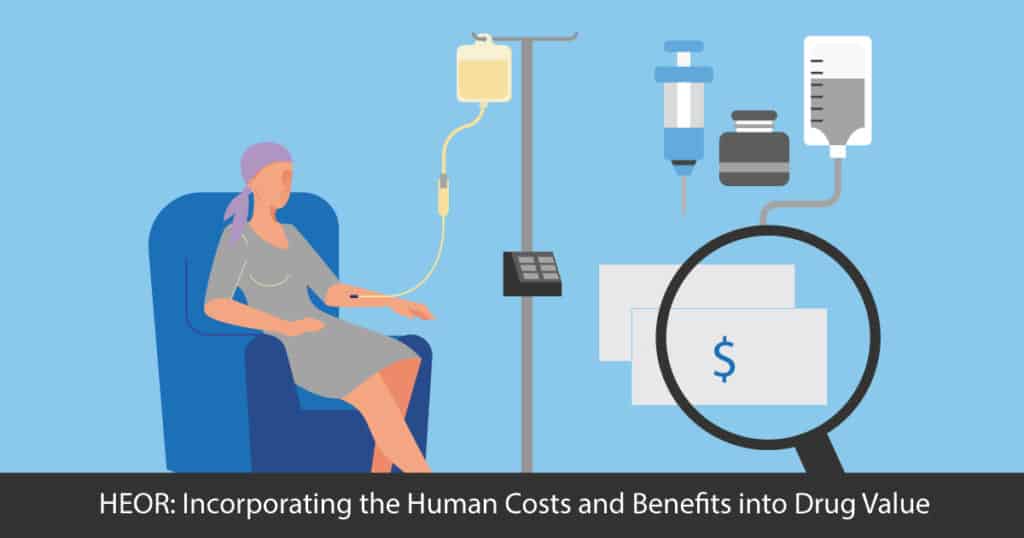HEOR: Incorporating the Human Costs and Benefits into Drug Value

By Kathleen Hoffman, PhD, MSPH
In a 2007 article, “Pinning Down the Money Value of a Person’s Life,” NY Times reporter Alex Berensen wrote,
“HOW much is your life worth? How about a year of life? How much is your vision worth? What about being pain-free? Able to walk unassisted? … Economists are sometimes accused of knowing the prices of everything and the value of nothing. Now they are trying to answer what may be the most difficult question of all — the price of health.”1
Berensen was covering the newly determined “quality-adjusted life year” or QALY. This “standard” was developed as a way of measuring in dollars a year of living in perfect health. Guess the price tag or value for living one year of perfect health in the US — it’s $50K to 150K.
As William Smith noted in his 2019 critique of the QALY, “A cancer drug that provides “only” eight additional months of life won’t achieve a maximum QALY score. Yet to someone with a cancer treated by that drug who may be facing certain death, a drug that delivers an extra eight months of life should get the highest possible rating.”2
The National Council on Disability stated in their 2019 monograph on QALY:
When health insurance will not cover medically necessary medications and treatments, individuals experience poorer health and a lower life expectancy. Nonetheless, in an effort to lower their healthcare costs, public and private health insurance providers have utilized the Quality Adjusted Life Year (QALY) to determine the cost-effectiveness of medications and treatment. QALYs place a lower value on treatments which extend the lives of people with chronic illnesses and disabilities.3
A webinar4 and journal article5 presented by ISPOR illustrates the striking difference in perspective between those who utilize QALY and Health Economics and Outcomes Research (HEOR) researchers working in the pharmaceutical industry, that is, patient experience is incorporated in their research.
ISPOR is a 20,000 member organization of HEOR professionals.6 When ISPOR’s Patient Centric special interest group (PC-SIG) sought to determine if patient engagement was being done well, they discovered a lack of agreement as to what “patient engagement in research” meant. The objective of the research presented in the webinar was to create a unified definition of patient engagement and describe it in-depth to help researchers implement patient engagement into study design effectively.
Developed through literature review, qualitative content analysis and a partnership of diverse stakeholders including academics, researchers, payers, and patient advocacy organizations, National Health council researcher and patient advocate Eleanor Perfetto calls this definition a “north star” to guide patient engagement efforts.4 The five-year project resulted in the following description for patient engagement:
The active, meaningful, and collaborative interaction between patients and researchers across all stages of the research process, where research decision making is guided by patients’ contributions as partners, recognizing their specific experiences, values, and expertise.5
One of the precepts of HEOR is that health care as a whole can only benefit from balancing any intervention’s financial value with a scientific evaluation of its total outcome, including data on the intervention’s value from the patient perspective. Outcomes research, the second half of HEOR, is a discipline that places value on what is happening to, and the results of an intervention on, people. Outcomes are real world experiences, and include quality of life, side effects, opportunities, emotional and spiritual losses, as well as adverse reactions—not just the length of one’s life. HEOR seeks to bring together the dollars and cents value of an intervention with its human impact. According to ISPOR, the top HEOR trend of 2020 is Real World Evidence, gathering and analyzing data based on patient experiences of interventions.7
One of the webinar panelists was Ron Camp, a senior manager of patient engagement at EURORDIS, Rare Diseases Europe, a non-profit alliance of rare disease patient organizations that work together to improve the lives of people living with a rare disease in Europe.8 As he put it, “Patient lives depended on the outcome of research, but patients had no input into [research design or outcome].” 4 ISPOR is trying to lower those barriers by creating and disseminating a scientifically-based and peer-reviewed definition of patient engagement.
During the webinar, held July 16, Maya Harra of Boehinger-Ingelheim (BI) talked about how their dermatology division is including patients as partners in product development. Patient input is being used to inform payers about unmet needs of dermatologic patients, including under-recognized conditions, to encourage payer support for aspects important to patients. Some of the methods BI is using include a payer survey and a patient advisory board. She emphasized that management leadership is key to a corporation’s cultural shift toward patient awareness. “Highlight successful use cases throughout the organization.”4
As moderator Rachel Harrington, PhD, a Research Scientist on the National Committee for Quality Assurance put it, the most important principle to be taken from the ISPOR research is that patient engagement should be started early in the development process and be continuous end-to-end, with patients considered as partners and co-researchers. “Patient voices are the sounds of experience… Patient engagement “hold[s] research teams accountable for making research meaningful.”4
Inspire offers a trusted community to patients and caregivers. Our goal with this blog, this website and our content is to provide the life science industry access to the true, authentic patient voice. In so doing, we support faithful operationalization of patient-centricity. Take a look at our case studies, eBooks and news outlet coverage.
References:
1Berensen, A. (June 11, 2007). Pinning down the money value of a person’s life. The New York Times. https://www.nytimes.com/2007/06/11/business/businessspecial3/11life.html.
2Smith, W. (February 22, 2019). The US shouldn’t use “QALY” in drug cost-effectiveness reviews. STAT. https://www.statnews.com/2019/02/22/qaly-drug-effectiveness-reviews/
3National Council on Disabilities. (November 6, 2019). Quality Adjusted Life Years and the devaluation of life with disabilities: Part of the Bioethics and Disability Series. https://ncd.gov/sites/default/files/NCD_Quality_Adjusted_Life_Report_508.pdf
4Harrington, R., Camp,R. Perfetto,E., McBurney, R. (July 17, 2020) for “Patient Engagement in Research: An ISPOR Definition” [webinar].
5Harrington, Rachel L. et al.Defining Patient Engagement in Research: Results of a Systematic Review and Analysis: Report of the ISPOR Patient-Centered Special Interest Group
Value in Health, Volume 23, Issue 6, 677 – 688 https://www.ispor.org/publications/journals/value-in-health/abstract/Volume-23–Issue-6/Defining-Patient-Engagement-in-Research–Results-of-a-Systematic-Review-and-Analysis–Report-of-the-ISPOR-Patient-Centered-Special-Interest-Group
6https://www.ispor.org/about/our-members
7https://www.ispor.org/heor-resources/about-heor
8https://www.eurordis.org/






